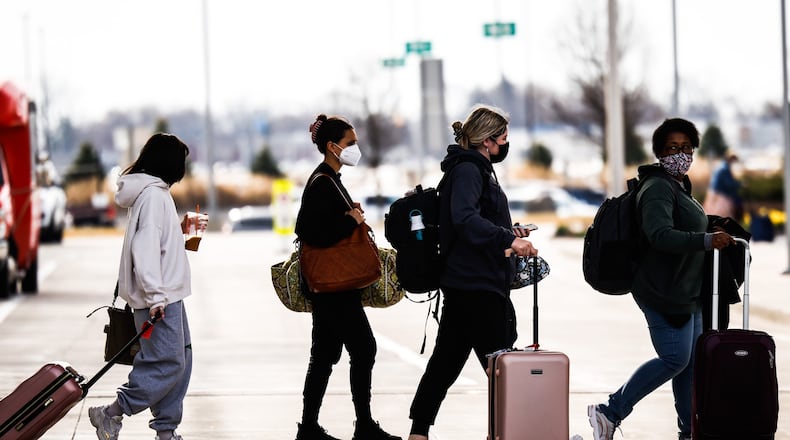Domestic flight bookings in February drove $6.6 billion in spending, 6% above February 2019 levels, according to the analysis. That also represented an 18 percent increase from January ($5.6 billion). It also was “well above” what consumers spent in November 2021 ($5.5 billion) and December 2021 ($3.2 billion) when concerns over Omicron variant of COVID-19 dampened demand.
But as demand picks up, so have prices. In February, prices were 5% higher compared to 2019 levels.
“Contrast that with January 2022, where prices were 3 percent lower than 2019 levels,” the ADEI analysis said. “Inflation in ticket prices have been a contributor to the uptick in online spending: While revenue is up 6 percent versus 2019 levels, as cited previously, actual bookings are up just 4 percent.”
Aviation expert Jay Ratliff told this news outlet that airlines started to raising fares during the pandemic to make up for the revenue hit from the drastic reduction in the amount of premium, corporate travelers, who historically provided airlines 70% of their revenues because of flying multiple times a week on significantly higher, non-restricted fares.
“They’re looking at what they need to do to adjust their business plan to try to respond as much as one can to that much of a significant drop in revenue,” Ratliff said.
The increase in tensions between Russian-Ukraine also are pushing oil prices higher, which has sent the cost of producing jet/airline fuel to an eight-year high. Those tensions also are preventing airlines from capitalizing on one of the bright spots they were looking forward to this summer: the return of international travel.
“So you have all of these things working against them at a time with increased operational cost when their revenue is down significantly,” Ratliff said. “There’s two options (of what airlines can do). They can say the routes that are no longer profitable for us because of the rise of fuel (costs), we’re going to temporarily suspend service to those areas.”
That’s exactly what airlines like Allegiant, Alaska Airlines and a few others have done in recent months, he said.
The other option is airlines raising airfares, something Delta Airlines announced last week) with a 10% rate hike across the board at least, Ratliff said.
“That’s going to continue to increase (and) other airlines are expected to follow, so you’re seeing airlines trying to do what they can to raise increases from the fares to try and recoup some, certainly not all or even close to it, of the revenue that they’re losing,” Ratliff said.
Airlines could have raised fares toward the start of the pandemic to make up for the lack of travelers, but didn’t do so, according to Adam Pilarski, senior vice president with Chantilly, Va.-based aviation consulting firm Avitas Inc.
Two years later, after three rounds of federal bailouts for the industry, an integral part of and crucial contributor to the U.S. economy, that safety net is gone. To make matter worse, “costs are going up all the time,” including not just oil prices, but also the cost of having to thoroughly sanitize planes between each flight, Pilarski said.
Pilarski said it makes sense that airlines should try to raise fares.
“If you think about longer term in the next year or two, fares have to go up,” he said. “There is no way around it.”
Even without any turmoil between Russian and Ukraine, costs will continue to rise for airlines having to spend their time, resources and personnel ensuring and enforcing COVID compliance. But with fewer people flying business class seats that help pay for flights, those in coach will be charged more to make up for lost revenue, he said.
The average price of a domestic round-trip ticket has increased 26% over the last year to $290, according to price-booking app Hopper. Airfares are expected to increase 7% each month until June, Hopper recently said.
Dayton International Airport had average inflation-adjusted domestic fares of $373.56 for the quarter ending Sept. 30, up from $367.23 in the second quarter of 2021, according to the latest available U.S. Department of Transportation data.
That’s a 1.7% increase from the second quarter.
Dayton’s average airfare is higher than other larger Ohio airports, such as Cincinnati (CVG) at $285.58 and John Glenn Columbus (CMH) at $323.12.
The national average fare increased to 314.39 in the third quarter, marking a 3.2% increase from the second quarter of last year, when it was $304.59, and a 22% increase from the third quarter of 2020, when fares were 257.77, according to the Bureau of Transportation Statistics.
Averages do not include frequent-flyer or “zero fares.”
What consumers can do to combat that is book their flights as far as possible in advance with trip cancellation insurance to lock in lower fares and guard themselves from any future fare increase, Ratliff said.
He also advises to routinely check airlines and third-party sites each and every day, preferably in the morning, when fares are first loaded, to get a sense of what the actual going rate is for a flight, then book it when the fare drops. That, he said, makes for more informed purchase than logging in one day and not knowing if a fare is a bargain or not.
That doesn’t mean that those looking for a quick discount fare should despair, Ratliff said.
“If they see a future flight in a certain market is soft on the advance bookings, they might throw out a low fare,” he said. “They may throw out six seat at a highly discounted fare just to generate some revenue for that flight.”
About the Author

